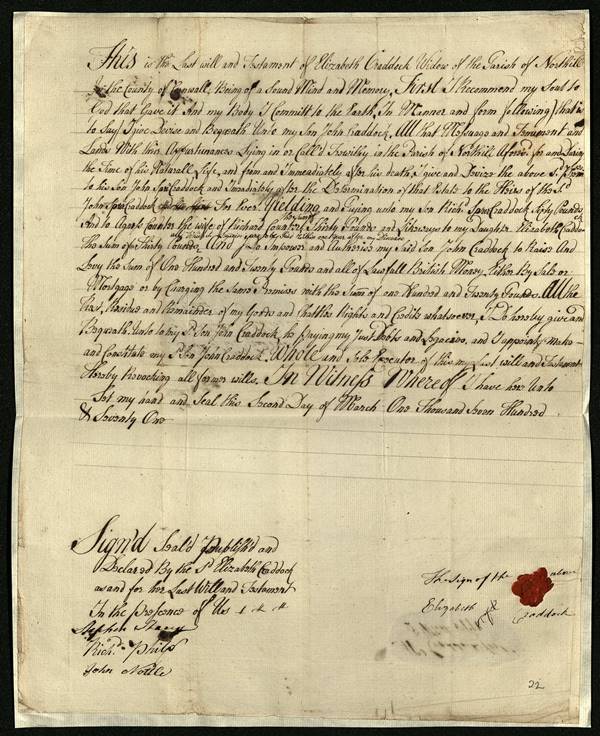
CRADDOCK |
||||
|
The Craddock family lived in North Hill from 1723 to 1851, as Craddocks, and trace their origins back to the area around St Minver, St Kew and St Endellion on the east of the Camel estuary. Descendants of the Craddocks were still living in North Hill in the latter half of the 20th century and there may still be some in the parish today. Some of the family surnames descended from the Craddocks are like a Who's Who of North Hill life and include :
Alford - Basset - Bennett - Caunter - Doidge - Doney - Foott - Hocking - Laundry - Maunder Mitchell - Moyse - Pearce - Perry - Reed - Sleep - Spoure - Tucker - Vosper The story of the connection with North Hill begins with the birth of two boys, Humphrey Craddock and John Craddock both born around 1700. Whether they were cousins or brothers or unrelated is not definitively known. We do know that:
There are two significant events that influenced the arrival of the Craddock family in North Hill and the parts that these events contribute to the narrative will unfold below. The two events are the deaths of Joan Craddock (nee Curnock) in St Endellion in 1757 and Elizabeth Craddock (nee Spoure) in North Hill in 1771. The first record we have of a Craddock family member in North Hill is that on the 24th of October 1723 in St Torney's Church in North Hill was celebrated the marriage of local girl Elizabeth Spoure and John Craddock of St Breward, son of John and Joan shown above. Elizabeth was the daughter of Richard and Blandina Spoure of North Hill and a member of the 'lesser' branch of the Spoures They spent their married years living in St Breward where John's parents farmed. John died in 1747 and his mother, Joan, died in 1757. Both died and were buried in St Breward. The death of Joan is the first of the two events that brought the Craddocks to North Hill. John and Elizabeth had four children:
Elizabeth, having been widowed in 1747 continued living with her mother-in-law, Joan, in St Breward. The home was held in Joan's name and her death 1757 meant that occupation of the home had to be relinquished. This was the first of the two significant events mentioned earlier because Elizabeth was now in need of a home for herself, Agnes and Richard. At this time Elizabeth was in her mid fifties. Agnes and Richard were in their early twenties and unmarried. She left the premises in St Breward and moved back to her childhood home of North Hill. It is interesting to speculate on her motivation to return to North Hill. Elizabeth had not lived in North Hill for over 30 years and it would be reasonable to think that she had rejoined her own family but this appears not to have been the case. Her parents had died 1751 and 1752; her one other sibling was Mary who had died, childless, in 1733; Elizabeth's maternal grandparents had died by 1710 and her paternal grandparents had died by 1730. Elizabeth's maternal great grandmother was the long since deceased Temperance Vincent who had a family connection to the Darley family living in Battens Farm in North Hill at the time of Elizabeth's need for a home. There was also a potential link to the Spoures of Trebartha Hall. It is possible that she invoked one of these connections to secure a home that the family could farm.
|
||||
|
Some Notable Family Members
Mary Nicholas nee Craddock (1845-1914)
It is believed that Mary died in July 1914, a month before the start of the First World War and was spared the knowledge that at least three of her sons fought on the Western Front. James and Fritz were killed there and Arthur was wounded twice and gassed but survived the war only to be killed in a freak accident in 1933 (see article "Trailer Mounts Pavement" below, click on the article for a larger image). Alfred died in 1922. |
||||
The banner image shows the locations of St Endellion, St Minver and St Kew. Polzeath, on the estuary of the River Camel, is also marked as a guide for the reader. |




 Mary Craddock was born in Egloshayle in 1845. By 1870 she was living in London and married in October to Police Constable Alfred Nicholas. They had eight children in the period from 1871 to 1888 and lived all this time in the Chelsea area of London.
Mary Craddock was born in Egloshayle in 1845. By 1870 she was living in London and married in October to Police Constable Alfred Nicholas. They had eight children in the period from 1871 to 1888 and lived all this time in the Chelsea area of London. 